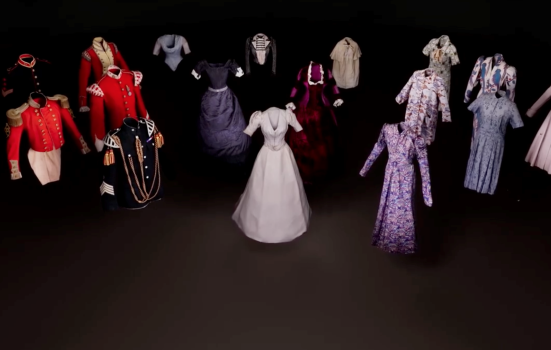Digitising collections is an ongoing challenge for museums, as evidenced in the latest National Museum Partnership report. Fiona Morris and Charlotte Morgan discuss the potential of cross-cultural and technical partnerships as a solution.

Cornwall Museums Partnership
The recent report commissioned by the Department for Culture, Media and Sport acknowledged the lack of digital capacity in the national museums’ partnership and suggested that partnering with tech and media companies could provide solutions to the need for in-house digital skills, resources and infrastructure.
However, it is hard for these projects to generate revenue immediately and while there is lots of potential for innovation, these are very early models which we don’t yet have a structure for. We need to acknowledge that this is a period of experimentation.
Within this culture of experimentation is the Beyond Digitisation project - in which three of the museums under Cornwall Museums Partnership (CMP) - Penlee House Gallery & Museum, Bodmin Keep and Royal Cornwall Museum - worked with a tech start-up company to capture high-quality 3D scans of some of their fashion and military uniform collections.
This was a really interesting project which captured some of the collections to see whether they could license the models and to discover if there could be earning potential, for example, through licensing the images to the gaming and film industries as well as making the collections more accessible.
The beginning of a puzzle
CMP was interested in the role of digital engagement and collection development and, through a partnership with Falmouth University, it worked with a tech start-up company whose business model involved exploring heritage costumes with the potential to market them to the commercial sector.
Digitisation of CMP’s assets was financed by Art Fund. Although there has been some interest in licensing from the gaming sector, other benefits have emerged. The monetisation results weren’t game-changing, but they didn’t expect that. Fundamentally, for CMP, it was about capturing great quality scans and thinking about how they might use them in interpretation and exhibition. This is the beginning of a puzzle, which will continue to be monitored for any commercial conclusions.
Ethical and IP questions
Ordinarily, a museum using a digital capture company would simply hire someone and retain the rights to the asset, but this project raised questions around IP ownership and licensing.
For CMP, embarking on a potentially commercial partnership was more complicated. What they eventually settled on was a shared licence and commercial agreement for the use of the assets and they built in a museum veto allowing them to rescind the licence for the asset if they felt it wasn’t going to be used in an ethical way.
 Beyond Digitisation project. Photo: Cornwall Museums Partnership
Beyond Digitisation project. Photo: Cornwall Museums Partnership
With military uniforms, for example, the worst-case scenario is that there could be an identifying number or symbol - these uniforms belonged to individuals - and that means something. CMP obviously doesn’t want the scan to be used in a scene where that uniform is worn by someone who is killed or is particularly violent.
It’s about ethical use of the collections and this was a particularly sensitive topic to navigate. Museums are naturally risk averse but a tech start-up going through an innovation or exploration programme wants to be ambitious. These ethical questions around digital assets need to be addressed, especially when working with a third party.
Overcoming the challenges
CMP faced other challenges when unexpected issues arose. Some of the museums didn’t have computers that could upload the files. It was frustrating and has since been remedied but it is something for other museums to factor into their thinking and planning.
Also, in practical terms, though CMP now has fantastic quality scans, it wasn’t always easy. The military uniforms have lots of shiny details on and these were tricky to capture. It’s a simple thing but also useful for others to be aware of’
Due to the delicate nature of fabric - some of the pieces are hundreds of years old - handling them for display can be detrimental. With the incredibly detailed scans, users can examine the garments in close-up, turn them 360* and even view the insides to see how they were constructed. This is another form of conservation. Some of the pieces are incredibly delicate and these scans show far more detail than a simple photograph or even a costume in a case would.
Making digitised collections accessible
The reality of making digitised collections truly accessible, particularly if they are to attract a commercial market is very expensive, and still people don’t know how to find the stuff. If you’re really going to have a comprehensive collection, you need to market it and address all the legal ramifications.
Income might be one measure or perhaps it could be in the making of a Creative Commons with availability for licensing. We have to think about these things and find the sweet spot.
But the project has been a step forward for the collections. CMP can be more flexible and innovative and can share assets across the county and beyond without the expense and challenges of moving physical costumes. The really exciting part is that it can tell broader stories.
Fiona Morris is Chief Executive and Creative Director at The Space (Digital Arts).
Charlotte Morgan is Head of Museusm, Development and Partnerships at Cornwall Museums Partnership.
![]() thespace.org | cornwallmuseumspartnership.org.uk/
thespace.org | cornwallmuseumspartnership.org.uk/
![]() @thespacearts | @FionaMorris_ | @cornwallmp
@thespacearts | @FionaMorris_ | @cornwallmp
This article, sponsored and contributed by The Space, is part of a series spotlighting new ways of creating and distributing digital content, and exploring the wealth of new technologies and platforms coming online.






